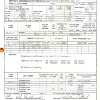IMR 3031 was a popular 30-06 powder from the 1960 articles in the American Rifleman. The experienced match shooters said not to use powders faster than IMR 3031 or slower than IMR 4064 in your M1a. When I got into NRA Highpower the Garand had been replaced by the M1a. Though it was sort of a right of passage to build your own NM Garand.
I do know the 86 year old ex Gun Club President was reloading 30-06 match ammunition with IMR 3031, because I have looked at what he was shooting.
The old IMR 3031 had long and thin powder granules. That did not throw consistently through my Dillion 550B, so I primarily used IMR 4895 which is short grained. I also knew that IMR 4895 was the powder used in the Garand and M14 National Match ammunition of the 1960's. And that IMR 4895 was the WW2 30-06 powder. I still consider IMR 4895 "the baseline" powder for the 30-06 Garand.
Recently I purchased a keg of IMR 3031 and now it is short grained! Took long enough. It worked great in my 30-30. I did use IMR 3031 long grain in my M1a, and it shot very well, functioned the mechanism perfectly.
I have gotten to prefer faster powders to slower powders in gas guns, since I learned about gas system pressure curves. As a rule, a powder that quickly drops pressure as the bolt unlocks, will tend to be easier on the mechanism, and provide more reliable extraction, all things being equal. The more reliable extraction comes from the residual blow back effect, where breech pressure pushes the case out after unlock. This does not work well at all if the case is sticking to the chamber, A slow powder will maintain a high breech pressure at unlock, even though the maximum breech pressure is the same.
Still, I consider IMR 4895 "the baseline" powder for the 30-06 Garand. You can't go wrong with any of the 4895's, that is AA2495, H4895, and IMR 4895. You won't go wrong with IMR 3031 short cut as long as you keep velocities and pressures appropriate for the Garand.
I will say, load your 150's to "around" 2700 fps, your IMR 3031 will function your Garand just fine. More does not mean more. More does not get you more with the Garand. Its when velocities and pressures are pushed is when you will experience malfunctions. I have not seen them all, but I saw enough malfunctions with commercial ammunition on the firing to learn to roll my own. Old NM ammunition was impossible to find. At the time, there was no "Garand" specific commercial ammunition
View attachment 1135007
View attachment 1135008
This is real lot acceptance data for WC852 ball powder. It was used in the 30-06
View attachment 1135005
A couple of things fall out. The 2750 fps velocity is only valid in one Frankford Arsenal pressure and velocity barrel. The Government Buyer is using calibrated cartridges from that Frankford Arsenal and guess what, the velocity of the Winchester barrel is "corrected" to the Frankford Arsenal values. Instead of the Frankford Arsenal cartridges giving 2750 fps in the Winchester barrel, they are reading 2675. You can also see chamber pressures are 40,200 to 41,800 psia. There are jokers who love to play three card Monte with psia and CUP and claim 60,000 psia is where you want to be with Garand ammunition. Presumably because more means more. And one advocate of hot loads is out to prove GARANDS ARE STRONG! At the time CUP was thought to be psia, and getting 2750 fps at a lower than the WW1 maximum of 50 K CUP was better, and easier on the mechanism. And that is where reloaders want to be. I ran my 168's around 2650 fps and my 150's around 2700 fps. My Garand functioned reliably and I shot good groups.
Incidentally, this is what I got using 59.5 grains of this powder with a 148 gr IMI military bullet
CMP Danish M1 Garand with VAR barrel
148 IMI FMJBT
59.5 gr WC852 IMI cases CCI200
4 April 2009 T=72 ° F
Ave Vel = 2683
Std Dev = 18
ES = 57
Low = 2647
High = 2704
N = 8










